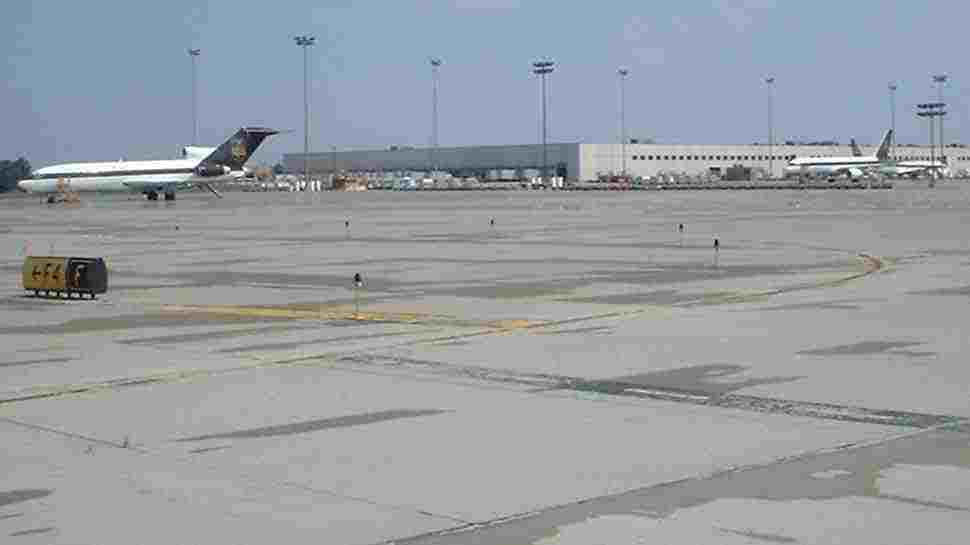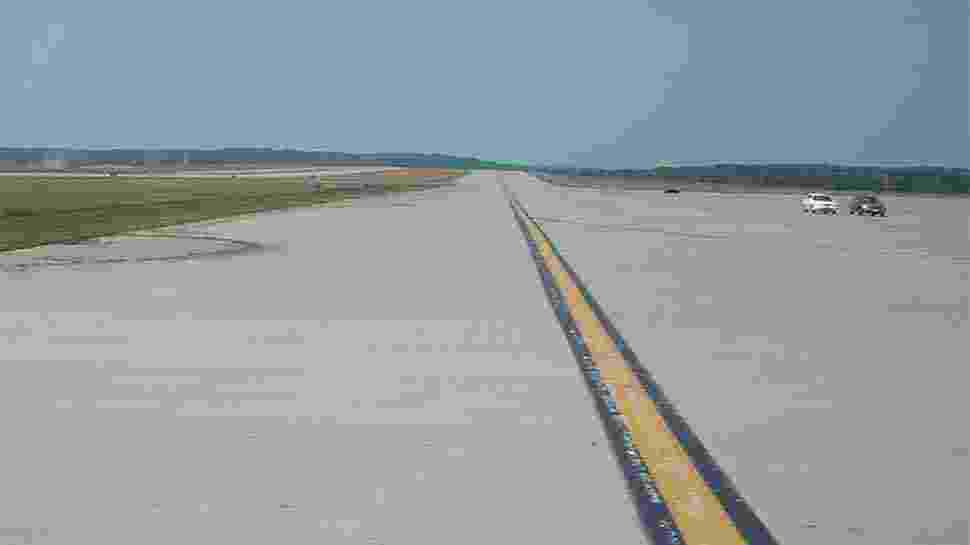
The weak link in concrete pavement is the control joint. Slabs curl upward at joints, causing a rough ride as traffic crosses them. Joint edges are prone to deterioration and damage (especially from snowplows), resulting in spalling, which makes the ride even rougher. In the case of airport pavements, spalls create a significant danger of loose concrete chunks getting sucked into jet engines. Joints require frequent maintenance to keep them sealed, an ongoing expense that increases as the joints become damaged. An inspection team reported that, even after 10 years of heavy use, the Type K post-tensioned pavement appeared in almost new condition.
In the early 1990s, two engineers devised an elegant solution for the problems caused by joints: eliminate them. They designed a jointless slab by combining post-tensioning and fiber-reinforced, shrinkage-compensating, Type K concrete. Their proof of the concept was an ambitious demonstration project at the Rockford, Ill., airport – a taxiway 1,200 feet long by 75 feet wide with no joints in either dimension. After 14 years of heavy use, the demonstration slab is in far better condition than an adjacent conventional slab.
Damage Control
Control joints are considered unavoidable in conventional concrete slabs, a necessary evil to combat drying shrinkage cracking by creating weak spots that encourage cracking in neat, straight lines at evenly spaced intervals. Shrinkage-compensating concrete does not eliminate shrinkage. Rather, it prevents shrinkage from causing cracks because the Type K concrete expands during its critical first seven days to offset subsequent shrinkage.
Shrinkage-compensating concrete was invented in the early 1960s and has been widely used in a variety of large-scale public works projects including airport runways, parking structures, and large hydraulic structures. The Rockford airport project, however, took the concept farther—literally—than ever before.
Bruce Raterree, P.E., then chief engineer of Crawford, Murphy & Tilly, Springfield Ill., and Ernest Barenberg, Ph.D., professor of civil engineering at the University of Illinois at Champaign-Urbana, wanted to test the limits of joint minimization. Barenberg had been involved with long, post-tensioned pavements placed at Chicago’s O’Hare airport in 1980. There, conventional portland cement concrete was used to pave two, 400-foot lengths at the end of runway 27 Left, at that time the busiest takeoff runway in the world. They were able to pave 400 feet at a conventional width of 30 feet in one day, then immediately apply low-level post-tensioning in the longitudinal dimension. Six such lanes were paved, then post-tensioned transversely as well.
“There was a little problem with a joint that got hit by a snowplow and had to be repaired,” said Barenberg, “but other than that, they’ve done almost no maintenance on those slabs in 27 years. I wanted to get another post-tensioned pavement going so we could get the industry interested. Every post-tensioned pavement that has been built has performed exceedingly well.”
Barenberg and Raterree grew more ambitious. They knew about shrinkage-compensating concrete and began to wonder what would happen if they combined it with post-tensioning.
“We were trying to push the envelope, to see how far we could go in expanding the joint length,” explained Barenberg. “We could pave a lane 1,200 feet long in a day, but it would tend to crack early, before you [applied] post-tensioning. Shrinkage starts after a few hours, and the concrete at that time has very little tensile strength.”
Because Type K concrete does not start to shrink for seven days, they reasoned it would allow them more time, perhaps even several days worth of placement, before tension had to be applied. Then, post-tensioning would put the entire length of concrete into permanent compression, so no transverse joints would be needed.
By using a bridge-deck paver, they could lay down 75-foot widths of pavement in a single pass, eliminating longitudinal construction joints. Steel fibers mixed in the Type K concrete would provide enough internal restraint to prevent longitudinal cracks: neither joints nor post-tensioning across the slab would be needed.
Barenberg calculated that he could counterbalance the cost of post-tensioning by reducing the total amount of concrete. “You gain considerable strength in concrete when you post-tension it. We were putting it into about 250 pounds per square inch of compression. For any load to crack that, it first has to overcome that compressive force, and any tensile strength that you might have in the concrete as well.” Barenberg calculated that he could reduce slab thickness by more than 50 percent, from 15 inches down to 7 inches.
Taking Shape
It took them more than six years to get a project to prove the concept. In the early 1990s, what is now Chicago-Rockford International Airport was seeing increased traffic, and needed to extend one taxiway. Raterree proposed to the Federal Aviation Administration (FAA) to use that extension as a demonstration of innovative pavements. The plan evolved into three slabs, one conventional and two innovative. All were paved 75 feet wide in a single pass using an 85-foot-wide bridge deck paver.
The conventional “control” slab was 560 feet long, designed in accordance with FAA Advisory Circular No. 150/5820-6C: concrete with Type I portland cement, 15 inches thick, with 18.75-foot longitudinal joint spacing and 20-foot transverse joint spacing. Shrinkage control joints in both dimensions were saw-cut after placement.
The second slab was an innovative pavement 900 feet long, using shrinkage-compensating, Type K concrete and containing 85 pounds of steel fibers per cubic yard. Its purpose was to test the natural cracking interval of the material by placing joints at varying distances, all of them greater than conventional jointing. The spacing of the transverse joints varied from 85 feet to 200 feet. There were no longitudinal joints. Moreover, the flexural strength gained from the steel fibers allowed them to reduce pavement thickness to 10 inches.
The third pavement was 1,200 feet long, made from the same Type K concrete containing 85 pounds of steel fibers per cubic yard, and post-tensioned longitudinally. It had no joints whatsoever. It was laid over a double layer of plastic film to reduce subgrade drag. It was also instrumented to measure internal temperature, strain, and slab movement.
Concrete Reality
Of course, real-world conditions can have unpredictable effects on even the best-engineered plans. The slabs were placed in 1993 during a very hot summer. The first two pavements were placed largely without incident. The 1,200-foot-long slab encountered two difficulties, which ironically, were gratifying to Barenberg.
In the early afternoon, while placing the post-tensioned pavement, a heavy rainstorm blew in. The design team had prepared for this contingency. The specification included a temporary header, ready to be placed at the free end of the slab whenever pouring had to be halted during the day. They also had burlap sheets to place over the freshly finished concrete in case of rain to protect the slab from getting water-pocked.
The following day, placing of the post-tensioned slab was completed. The temperature was about 95 degrees F, the recommended upper limit for Type K concrete placement. At higher temperatures, chemical reactions in the concrete speed up and set times are shortened.
Type K concrete also produces slightly greater heat gain during hydration than conventional concrete. Embedded instruments showed that the internal temperature of the slab peaked at 135 degrees F. That night it dropped 40 degrees to 95 degrees F.
On the third morning, when the team arrived to apply initial post-tensioning, there was a single large crack across the width of the second day’s placement. It is theorized that the crack was caused by the severe temperature drop experienced the night before. (In contrast, the first day’s placement had been covered in rain-soaked burlap, which probably cooled it and minimized its temperature drop.)
By 10 a.m., as the day warmed up, thermal expansion of the concrete closed the crack to about 1/8 inch. Barenberg poured epoxy into the crack. Initial post-tensioning was then applied, essentially acting as a gigantic clamp, and the crack closed completely. It has stayed closed to this day.
Two years after the demonstration pavements were placed, United Parcel Service (UPS) moved its hub to the apron adjoining the taxiway. Eventually, air traffic reached double the level for which the taxiway extension was designed.
Proving the Concept
Despite increased traffic, the innovative pavements have performed well, especially the post-tensioned slab. The slabs were monitored quarterly for five years. During the first year, both Type K slabs developed longitudinal cracks. They appeared at distances ranging from 10 feet to 22 feet on either side of the centerline. They were short and very tight, not working cracks.
The Type K fiber-reinforced slab without post-tensioning also developed some transverse cracks in the first year, some of which run the width of the pavement. The pattern seems to suggest a natural cracking interval of about 40 feet—twice the joint spacing of conventional slabs. Even that cracking interval is curious, since much larger Type K slabs have been made elsewhere without any cracking.
The post-tensioned slab also developed some transverse cracks, but they were short and tight, not working cracks. There were also some longitudinal cracks along the edge related to extra edge-loading where UPS planes crossed onto the apron—loads not anticipated during design.
The conventional slab also developed random, transverse cracks despite the standard-spaced joints that were supposed to prevent them.
Ten years after the slabs were built, they were inspected using the Pavement Condition Index (PCI) developed by the U.S. Army Corps of Engineers and adopted by the FAA. The PCI provides a numerical value between 0 and 100 that defines the condition of a pavement, with 100 representing an excel-lent pavement.
The conventional slab had cracked and spalled considerably. While it was still usable, it was rated at a PCI of 68. The Type K slab without post-tensioning was in considerably better shape. Although there is no standard for rating fiber-reinforced, shrinkage-compensating concrete, the inspection team estimated its condition equivalent to a PCI of 85. The Type K post-tensioned pavement fared the best. Again, there is no standard for rating it, but the inspection team estimated its condition equivalent to a PCI of 98—almost perfect.
This assessment is echoed by Franz Olson, deputy director of operations and facilities, Chicago-Rock-ford International Airport. “The pavement has held up extremely well,” Olson reported. “The cracking has been very minimal.”
Barenberg said the Rockford demonstration offers a convincing model for economical paving. “It can cost less [initially],” he said, “and there’s certainly much [lower] life-cycle costs. ”His first contention is borne out by a recent cost analysis performed by CTS Cement Manufacturing Corp., manufacturer of Type K Cement. CTS found that at current prices for portland cement concrete, shrinkage-compensating concrete, post-tensioning, other materials, and labor, the per-square-yard cost of the Rockford post-tensioned slab is 8 percent less than for the Rockford conventional slab.
The airport’s experience indicates the innovative slabs also saved money in the long term through reduced maintenance costs. “We haven’t experienced any problems,” reported Olson. “With airport pavements you have to make sure joints are properly maintained and filled. By using the continuous pour, you’re eliminating all the additional maintenance.”
Best of all, the result is a better pavement that rides smoother and puts less wear on the vehicles that use it. Olson summed up, “I think it would be a good technology to pursue further.”
About the author: Michael Chusid, RA FCSI, is an architect, a Fellow of the Construction Specifications Institute, and a member of several American Concrete Institute committees. His company, Chusid Associates, consults on innovative construction materials and technologies. He can be reached at michael@chusid. com.
